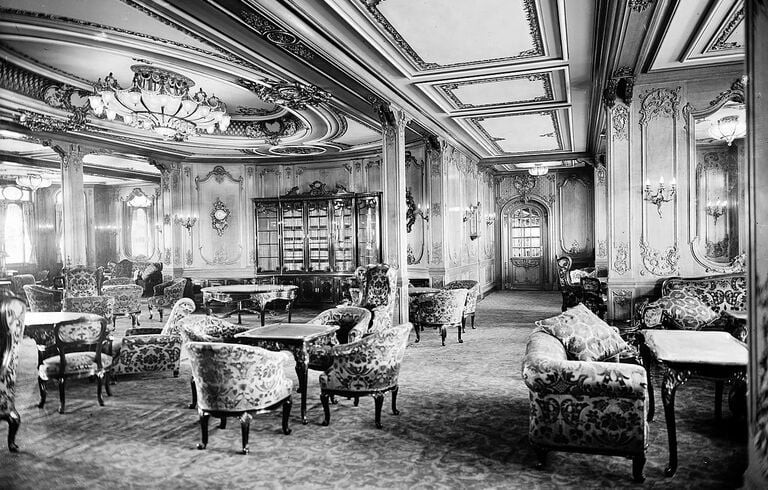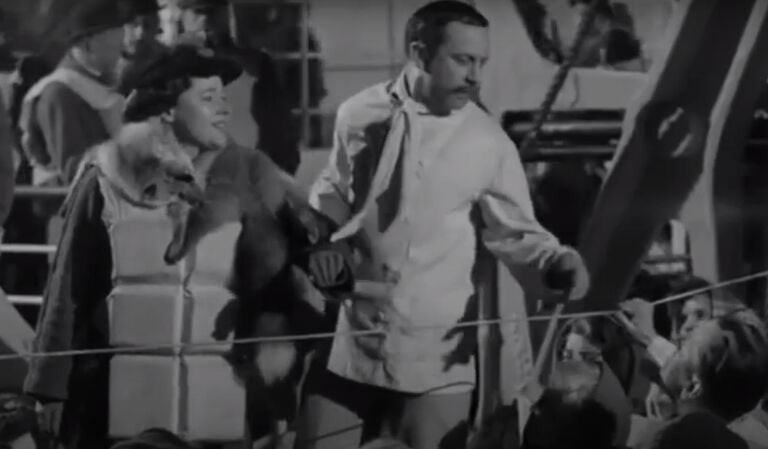
views
Tragedy of the Titanic: How the Ship's Baker Survived!
It was the early morning of April 15, 1912. Once again, human arrogance was about to claim its toll. The "unsinkable" Titanic was sinking in the icy waters of the Atlantic Ocean. Only a few people would survive the disaster, most of them wealthy first-class passengers. But not all.

This is the story of Charles Joughin - the head baker on board the Titanic. The story of his rescue is the most peculiar of this tragedy. For many years since the catastrophe, experts from around the world have debated how Joughin managed to survive unscathed. Today, they finally share their insights!
Unaware of the danger
Just a few days earlier, amidst great fanfare, the Titanic had left Southampton on its maiden voyage to New York City. At the time, the ship was considered "unsinkable."

It carried over 2,200 passengers and crew on its way to the New World. Little did they know they would soon encounter one of the worst disasters ever to occur at sea.
Stranded at sea
One by one, the Titanic's lifeboats were launched into the water. Many were only partially filled, leaving men, women, and children unnecessarily abandoned on the sinking ship.

As the hours passed, those remaining on board faced a terrible truth. No help was coming, and the only way to leave the ship was to jump into the frigid water below.
The arrival of the Carpathia
Tragically, the Titanic had long disappeared by the time the RMS Carpathia arrived to rescue survivors from the sea. According to History.com, only 706 people survived the sinking.

Most of them had managed to secure spots on lifeboats before the ship made its final plunge. But Joughin's story is different, telling how one man survived the catastrophe in a completely unexpected way.
A highly coveted position
When Joughin secured his position on the Titanic, it must have been a prestigious appointment. The White Star Line's ship was the largest in the world at its launch in 1911.

Weighing over 40,000 tons, the Titanic was reportedly nearly 900 feet long and up to 175 feet high. And that wasn't even its most impressive feature.
Unparalleled luxury
The true allure of the Titanic lay not in its size but in the sheer luxury that could be found on board. With a wide array of libraries, restaurants, smoking rooms, and even a swimming pool, the liner offered its first-class passengers the opportunity to travel in unparalleled style.

And, of course, many members of elite society had chosen to embark on the maiden voyage. The guest list included all the famous names of the time. It was chic.
Less glamorous conditions
Even below deck, many men and women from the third class, with $40 tickets (equivalent to about four months' wages for a worker at the time), were looking forward to a new life full of opportunities in North America.

But these people from both ends of the social spectrum would soon be united in a terrible tragedy that claimed over 1,500 lives. So how did a simple baker manage to have the luck to survive?
Smooth sailing at first
On April 10, 1912, the Titanic set sail from Southampton, England. It made stops in the French city of Cherbourg and then Queenstown in Ireland before heading across the Atlantic towards New York.

For the next four days, the Titanic's passengers experienced a relatively uneventful journey. But shortly before midnight on April 14, the great ship collided with an iceberg about 370 miles off the coast of Newfoundland.
Confronting the Ultimate Nightmare
As water flooded into the front part of the ship, Captain Edward Smith received the unimaginable news: Contrary to all promises, the Titanic would not stay afloat.

And so, the order was given to begin loading women and children into the lifeboats mounted on the upper decks. Unfortunately, there were not enough spots on board for everyone.
Slim chance of survival
Shortly after 2:00 a.m., the last lifeboat of the Titanic set off - and the remaining passengers faced a dreadful fate. With the Atlantic Ocean at 35 °F, it was much too cold for anyone to survive in for long.

But as the Titanic broke in half and began to disappear beneath the surface, the passengers on board must have realized they had no other choice.
The icy embrace of the ocean
Then the scene turned into a chilling horror as hundreds of passengers plunged into the icy depths. Tragically, the cold soon claimed the lives of most people who ended up in the water.

However, Joughin survived and miraculously managed to be rescued and brought to the United States. There, he told the story - thanks to some rather peculiar decisions in the face of the catastrophe.
An experienced baker
When he set sail on the Titanic, Joughin had already been a ship's baker for over ten years, according to the 1901 census. Originally from Birkenhead in northern England, he had served in the kitchens of numerous ships before ending up on the pride of the White Star Line.

It is even believed that Joughin had been at sea since the age of 11! What is unthinkable and prohibited in Germany today was commonplace worldwide back then and still is in many countries: child labor.
An enviable position
Joughin left behind a wife and two young children in Southampton and embarked on the maiden voyage of the Titanic as the head baker. According to the National Archives, he would have earned the handsome sum of £12 per month.

That would have been one of the highest wages on the ship at that time, more than ten times that of a dockworker. Leading a team of 13, he was responsible for producing fresh bread, pastries, and more.
A composed reaction
At the time of the deadly collision, Joughin was actually enjoying some downtime - dozing off in his bunk next to the ship's engine. Startled awake by the impact, the cook immediately sprang into action.

Joughin suspected that the people on board the lifeboats would need food, so he sent his bakers to quickly provide them with bread before they departed.
An interesting relaxation
After fulfilling his duty, the National Archives noted that Joughin retreated to the safety of his cabin, where he indulged in the luxury of an alcoholic beverage.

Refreshed, he made his way to his assigned lifeboat and began assisting women and children on board. However, many passengers hesitated to leave the perceived safety of the grand ship.
Persuading passengers
Apparently, Joughin eventually resorted to physically throwing women into the lifeboat - a gesture that may have saved their lives. But unlike many male passengers on the Titanic, the baker did not claim a seat for himself.

Instead, Joughin returned to his cabin one more time, where he had another sip of fortifying spirits. In a world where the wealthy had all the privileges, he did not believe in his own rescue.
Rising water levels
At this point, water began to seep under the door of Joughin's cabin. Apparently unfazed by the catastrophe, the baker made his way back up to the deck.

There, he began picking up chairs and throwing them overboard - creating flotation devices in the frigid ocean below. As Joughin stood at the stern, he heard a loud crack as the cruise liner broke apart.
A Great Step
But even that didn't seem to dampen Joughin's spirits. The Englishman held onto the railing, rode the sinking ship as it plunged into the depths and simply sank into the sea.

According to the National Archives, he didn't even dip his head into the waves. Instead, the surprisingly unharmed baker apparently swam away from the wreckage of the Titanic and permanently made his way into the history books.
Hours in the Water
Joughin swam in the water for almost two hours while others around him succumbed to the cold. Finally, as dawn broke, he spotted an overturned lifeboat with a group of men clinging to its hull.

Although there was no room on board, he paddled alongside until the crew of a second ship could pull the men on the lifeboat and himself out of the water.
Finally Rescued
Shortly after 4 a.m. on April 15, the steamship Carpathia arrived at the scene of the accident and began rescuing the icy survivors. According to the National Post, Joughin remained almost completely unharmed and later stated

"I was fine, except for my feet, they were swollen." But how could he accomplish such a remarkable feat when so many others lost their lives?
Internal Warmth
As it turned out, the secret lay in the many trips Joughin made back to his cabin - and in the secret sips of alcohol he drank throughout the night.

But weren't we always taught that alcohol in the bloodstream increases the risk of hypothermia rather than reducing it? Well, the truth was a bit more complicated.
Pleasant Side Effects
When we consume alcohol, blood from our vital organs goes to the surface of the skin, making us vulnerable to the harmful effects of extreme temperatures.

But Gordon Giesbrecht, a Canadian hypothermia expert and professor at the University of Manitoba, believes that in Joughin's case, the icy water would have caused his blood vessels to constrict. And this essentially reversed the effects of his alcohol consumption.
Just Enough to Survive
"With low to moderate doses of alcohol, the cold will win," Giesbrecht told the National Post in 2019. But if all the alcohol didn't provide Joughin with any physical advantage, then what was the key to his survival?

Interestingly, there is a scientific theory that alcohol, the good old liquid courage, could have played a significant role, especially immediately after the sinking.
Overcoming the Shock
According to the National Post, the initial shock of immersion in cold water lasts only about a minute and a half. And at temperatures around 15°C, the human body can actually survive at least 60 minutes before serious problems occur.

Considering that less than two hours passed between the sinking of the Titanic and the arrival of the Carpathia, why did so many people lose their lives?
A Steady Keel
Apparently, many of the victims did not survive the initial stages of cold shock. They panicked and thrashed around, causing their body temperature to drop and increasing the risk of drowning.

However, Joughin remained cool as a cucumber, metaphorically speaking, and that was partly thanks to all the alcohol he had consumed. So, the alcohol prevented panic.
Limiting Trauma
Some experts actually believe that the relaxing properties of alcohol can help the human body avoid trauma. According to a study from the University of Illinois at Chicago in 2012, injured individuals are more likely to survive if they have consumed alcohol.

In a statement, lead author Lee Friedman explained, "When intoxicated after injury, it appears to have a substantial protective effect and prevents panic or shock."
The Lucky One
Giesbrecht reiterated this opinion in his interview with the National Post. He said, "In an emergency room, hypothermia patients who are really drunk can walk in and be conscious and have a temperature they shouldn't have."

So, was it Joughin's decision to drink that kept him alive while others around him weren't so lucky? It was certainly a significant factor, at least.
An Extra Dose of Courage
According to Stephen Cheung, a respected professor at Brock University, the alcohol in Joughin's body likely gave him the courage to face the dire situation.

He told the National Post, "It would also diminish his sense of cold, so he might actually be more fearless and not feel as cold and therefore not panic as much."
A Claim to Fame
By remaining calm, Joughin managed to survive long enough to reach a lifeboat and survive the catastrophe that claimed so many lives. But that's not all.

On that fateful night, the baker gained the reputation of being the last man to leave the Titanic. And experts believe that this delay may have contributed to his success.
Good Timing
According to the National Post, delaying the moment of immersion is one of the key ways to survive a shipwreck. The later the jump into the water, the shorter the time until rescue from the water.

Being the very last person to plunge into the Atlantic that night - and living to tell the tale - Joughin is certainly proof of that. By staying behind to help others, he unknowingly improved his own chances of enduring the ordeal.
Overnight Celebrity
After a brief recovery period in New York, Joughin returned to England, where he was reunited with his wife and children. And less than a month after the sinking, Joughin was called to testify as part of the official British inquiry into the disaster.

Amazingly, his experience on the Titanic did not deter him from a career at sea. Presumably, if he had survived the greatest disaster of the time, nothing could shake him.
Disaster Strikes Again
In fact, before the outbreak of World War I, Joughin worked as a baker on the Titanic's sister ship, the Olympic, for some time. But evidently, he was not destined for a quiet life.

In 1916, while serving as a baker on the steamship SS Kongress, he experienced another horrific maritime disaster - this time in the North Pacific. By a twist of fate, this time it was the exact opposite of an iceberg.
Fire and Water
Reportedly, the ship was en route from San Francisco to Seattle when a brutal fire broke out on board. Just like on the Titanic, the crew began loading women and children into the lifeboats.

But this time, there was enough space for everyone. Lessons had been learned from the tragedy of the Titanic, and the number of lifeboats had been increased. Nevertheless, Joughin managed to add some drama to the situation.
Overboard Once Again
The newspaper Salt Lake Tribune reported on the front page: "Charles Joughin - a baker on the SS Congress - fell into the water while trying to board a lifeboat."

Fortunately, the lucky man was once again rescued unharmed from the sea. However, even that was not enough to keep him on land forever! Although he retired to land for a few years.
I'm Looking for a Fresh Start
However, the Encyclopedia Titanica noted that after the tragic death of his wife and newborn son in 1919, Joughin left England to start a new life in the United States.

He continued to work as a ship's baker on various ships there, but misfortune seemed to follow him. And on December 10, 1941, he was aboard the SS Oregon when it was accidentally rammed by an American battleship and sank.
Another War Episode
Apparently, 17 people lost their lives in this catastrophe. However, Joughin survived once again and served in World War II. In 1944, he finally retired after spending over five eventful decades at sea.

Despite his many heroic acts, he will forever be remembered as the intoxicated baker of the Titanic and as the last man to leave the infamous ship. One of the few survivors.
Literary Fame
But how exactly did Joughin's story become one of the enduring legends of the Titanic? Well, most of it can be attributed to the work of author Walter Lord, who published a detailed account of the sinking titled "A Night to Remember" in 1958.

During the writing process, he interviewed over 60 survivors, including the ship's baker. While many survivors could only recount general chaos, the baker provided many detailed pieces of information.
His Legend Lives On
However, Joughin would not live to see his story immortalized on the page. After being in contact with Lord in the 1950s, he passed away a year before the book's publication in a hospital in New Jersey.

But thanks to the incredible story told in "A Night to Remember," Joughin has gone down in history as one of the most famous survivors of the Titanic.
Other Unsinkable Heroes
Of course, Joughin was not the only one who managed to survive the Titanic with a story to tell. Let's take Margaret Brown, for example, who was dubbed "The Unsinkable Molly Brown" by the press.

As a wealthy American socialite, she is said to have played an active role in the ship's sinking - demanding the return of her lifeboat for the survivors and even operating an oar herself.
Film Portrayals
Then there was Second Officer Charles Lightoller, who was pinned underwater by debris before being propelled to the surface by a blast of hot air. Of course, the story of the Titanic's sinking has been told many times, with famous survivors and victims taking on a range of leading roles.

And Joughin is no exception, as he appeared in both the film version of "A Night to Remember" and the Hollywood epic "Titanic" in 1997. In fact, the story of the intoxicated baker is inseparable from that of the great passenger ship - a testament to the fact that survival skills are not always what we expect from them.




















Comments
0 comment